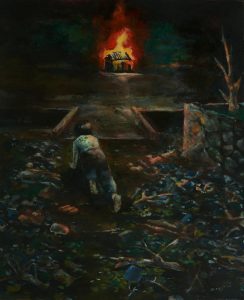My Life—Interview with Keiko Ogura (1937–), interpreter and A-bomb survivor, Part 3: Atomic bombing
Apr. 29, 2023
Witnessed tragedy with young eyes
by Hiromi Morita, Staff Writer
Ms. Ogura experienced the atomic bombing at a location 2.4 kilometers north of the hypocenter.
I had just turned eight years old and was a second-grade student at Ushita National School. In the morning on that day, my father said, “I have a hunch something bad is going to happen. I don’t want you to go to school today.” With that, I played by myself on a road north of our house. Suddenly, I was enveloped in a blinding flash and blown over. When I came to, I found that it was completely dark. A thatched roof nearby was in flames.
I returned home and found that the roof tiles and ceilings had been blown away, and that pieces of glass from a broken door were had been impaled in walls and pillars. After a while, a sticky gray rain fell and soaked my clothing.
My oldest brother returned to our house after suffering burns on his face and hands at a location to which he had been mobilized for work as a student. “The downtown is a sea of fire,” he said, a statement that greatly surprised me. I went out to see what had happened from the vantage point of a hill on which the neighborhood shrine was located.
A line of people with the appearance of ghosts flooded into the shrine. Their hair was burned and faces swollen and smeared with soot. Some were covered in blood, with skin hanging from their bodies. The shrine’s stone stairway was filled with the dead and dying.
Suddenly, someone grasped my ankle. “Water…,” said the person in a faint voice. I rushed home, drew water from a well, and returned to give it to that person, who died at that instant. It was horrifying. I regretted having given water to the victim. I determined not to tell anybody about that situation.
After that, I went back to the shrine again and observed maggots moving in and out of the skin of the wounded. You might wonder why an eight-year-old girl would keep her eyes locked on such a horrific scene. Other people who were injured or engaged in relief work did not have the leeway for such an experience. As a child, I was able to move around freely. I could not look away from the scene in which flies had swarmed on the injuries of the wounded and laid their eggs, which turned into maggots.
As a caretaker of the local community, my father seemed to be in charge of the daily work of disposing of corpses. I was an inquisitive little girl, so I pressed him to explain how the bodies were cremated, but he never told me. My half-destroyed house became filled with wounded relatives and acquaintances. Under the high temperatures of midsummer, nausea-inducing odors permeated the house.
Looking down on Hiroshima’s downtown area from the hill, I noticed the faraway sea close to me. I saw smoke from corpses being cremated arise from numerous places, with the smell sometimes reaching me. What I experienced at that time became emotional trauma that I was unable to share with anybody for a long time.
(Originally published on April 29, 2023)








